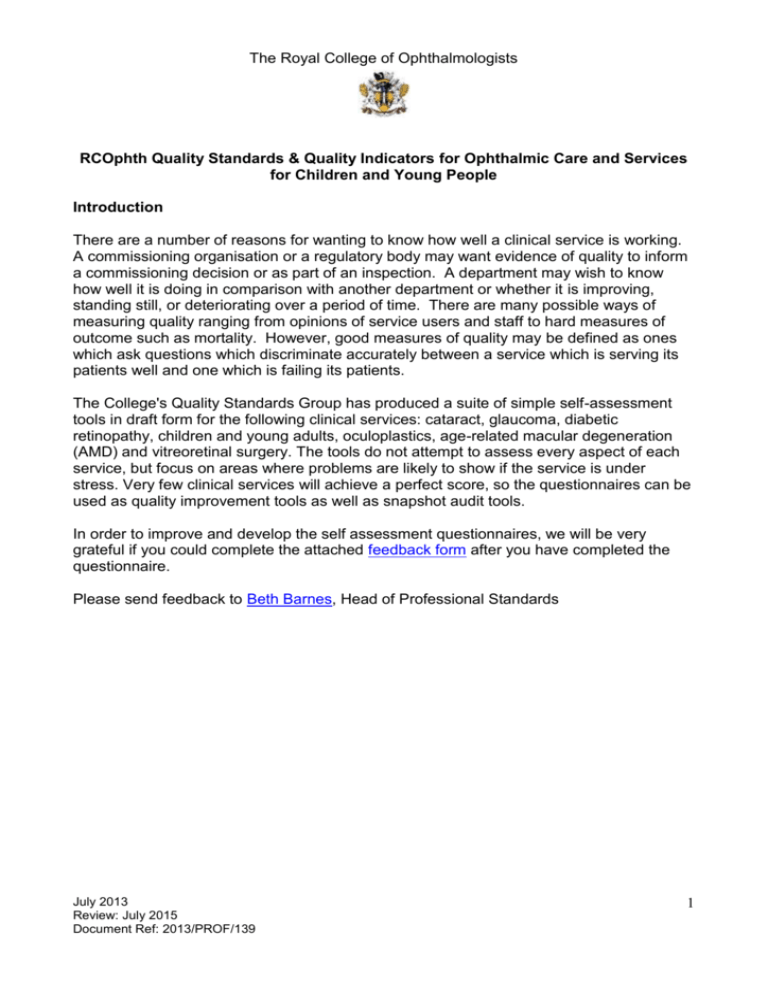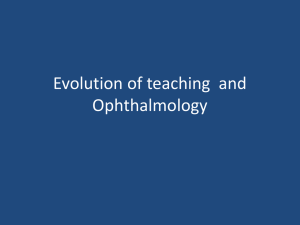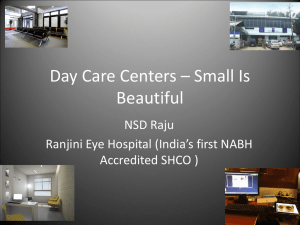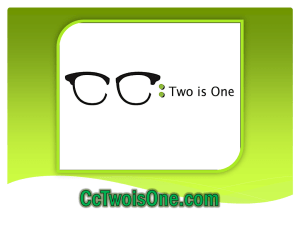GENERIC STANDARDS - the Royal College of Ophthalmologists
advertisement

The Royal College of Ophthalmologists RCOphth Quality Standards & Quality Indicators for Ophthalmic Care and Services for Children and Young People Introduction There are a number of reasons for wanting to know how well a clinical service is working. A commissioning organisation or a regulatory body may want evidence of quality to inform a commissioning decision or as part of an inspection. A department may wish to know how well it is doing in comparison with another department or whether it is improving, standing still, or deteriorating over a period of time. There are many possible ways of measuring quality ranging from opinions of service users and staff to hard measures of outcome such as mortality. However, good measures of quality may be defined as ones which ask questions which discriminate accurately between a service which is serving its patients well and one which is failing its patients. The College's Quality Standards Group has produced a suite of simple self-assessment tools in draft form for the following clinical services: cataract, glaucoma, diabetic retinopathy, children and young adults, oculoplastics, age-related macular degeneration (AMD) and vitreoretinal surgery. The tools do not attempt to assess every aspect of each service, but focus on areas where problems are likely to show if the service is under stress. Very few clinical services will achieve a perfect score, so the questionnaires can be used as quality improvement tools as well as snapshot audit tools. In order to improve and develop the self assessment questionnaires, we will be very grateful if you could complete the attached feedback form after you have completed the questionnaire. Please send feedback to Beth Barnes, Head of Professional Standards July 2013 Review: July 2015 Document Ref: 2013/PROF/139 1 PURPOSE and SCOPE The Royal College of Ophthalmologists has developed the Quality Standards and Quality Indicators / Metrics set out in this document with the aim of helping to improve the structure, processes and health outcomes of ophthalmic care and services for children and young people. At present there are few robust health outcome measures that can be used as quality measures for paediatric ophthalmology. Therefore the focus of quality improvement and measurement at present is on improving the processes of care that are considered to be linked to health outcomes. This document comprises a) Quality Standards for Ophthalmic Care and Services for Children and Young People, comprising overarching statements describing the key aspects of care/services for this population b) Quality Indicators / Metrics for Ophthalmic Care and Services for Children and Young People, for assessing the degree to which Quality Standards are being achieved, to identify areas for quality improvement and to measure the impact of quality improvement initiatives. These include the RCOphth Quality Indicators Tool for Paediatric Ophthalmology which focuses on key aspects of service provision and can be used as a quality improvement tool, an audit tool and to support professional appraisal and revalidation processes. Prepared by the RCOphth Paediatric Sub-committee for the RCOphth Quality Standards Group July 2013 Review: July 2015 Document Ref: 2013/PROF/139 2 Royal College of Ophthalmologists’ Quality Standards for Ophthalmic Care and Services for Children and Young People In a service providing ophthalmic care to children and young people: Quality Statement Source of Evidence Quality Indicators / Metrics Measurement method / actions 1 Care is child and family centred and accommodates the specific and changing needs of children and young people with ophthalmic disorders and/or visual impairment. Consensus a) Use RCOphth Quality Indicators Tool for Paediatric Ophthalmology (Items 1,3,4,5,6,11,12,16,21) Score as indicated. b) Evidence from parent and child (patient) experience surveys, using validated instruments where available, to examine different aspects of patient experience e.g. satisfaction with services, degree of ‘family centredness’ of services, quality of communications, accessibility of services Report dates, design and findings of survey and summarise actions to effect improvement (if any) with date for implementation date. c) Evidence of processes for transition of care to adolescent and/or adult services Report on development, use and audit of processes relating to transition of care RCOphth ‘Ophthalmic Services for Children’ NSF for Children Evidence synthesis e.g. Cochrane Reviews, Health Technology Assessment Reports , NHS Evidence, and other peer reviewed literature July 2013 Review: July 2015 Document Ref: 2013/PROF/139 3 Quality Statement Source of Evidence Quality Indicators / Metrics Measurement method / actions 2 Effective care, informed by research evidence, is provided in the areas of diagnosis, treatment and visual (re)habilitation of children and young people with ophthalmic disorders and/or visual impairment. Consensus a) Use RCOphth Quality Indicators Tool for Paediatric Ophthalmology (Items 6,7,8,9,10,12,16,17,18,19,20,21) Score as indicated. RCOphth ‘Ophthalmic Services for Children’ NSF for Children Evidence synthesis e.g. Cochrane Reviews, Health Technology Assessment Reports , NHS Evidence July 2013 Review: July 2015 Document Ref: 2013/PROF/139 b) Evidence that specialist clinical care is Report the clinical protocols in use provided which draws on the best available (and level of concordance) or in research, and, wherever possible, using development. agreed written clinical protocols c) Evidence that key clinical outcomes of health care are regularly assessed and compared, with adjustment for case mix, with available national or regional outcomes data. Report on development or use of an outcomes framework for routine/regular collection and evaluation of outcomes for the key disorders managed in the service. d) Evidence that patient reported outcomes are assessed, where possible using validated instruments. Report outcomes measured and comparison with outcomes from highest quality available sources e.g. from national audits or multicentre prospective studies. Report analysis of actions to improve outcomes (if any) with date for implementation. Report the patient reported outcomes used in outcomes framework and action to improve outcomes (if any) 4 Quality Statement Source of Evidence Quality Indicators / Metrics Measurement method / actions 3 There is a sufficient, skilled and competent multi-professional team providing ophthalmic care. Consensus a) Use RCOphth Quality Indicators Tool for Paediatric Ophthalmology (Items 3,6,18,19,20,21) ) Score as indicated. b) Evidence of service development informed by formal activity analysis and clinical audits Use activity analysis and clinical audits to identify gaps in manpower/personnel for planning service development. Report action to address these gaps. c) Evidence of annual staff appraisals to identify staff development activities and inform job planning Report on percentage of staff having appraisals each year and percentage achieving objectives set in the previous personal development plan. RCOphth ‘Ophthalmic Services for Children’ NSF for Children Quality Statement Source of Evidence Quality Indicators / Metrics Measurement method / actions 4 The general health, educational and social care needs of children and young people with ophthalmic disorders and/or visual impairment are recognised and addressed by working with relevant professionals and services. Consensus a) Use RCOphth Quality Indicators Tool for Paediatric Ophthalmology (Items 312,13,14,15,19) Score as indicated. b) Evidence of contribution to formal health, education or social care processes e.g. statement of special educational needs Record number of formal reports completed each year e.g. for statement of special educational needs July 2013 Review: July 2015 Document Ref: 2013/PROF/139 RCOphth ‘Ophthalmic Services for Children’ NSF for Children Warnock Report 5 Quality Statement Source of Evidence Quality Indicators / Metrics Measurement method / actions 5 Children and young people and their parents/carers are encouraged and supported to be involved in planning and providing ophthalmic care. Consensus a) RCOphth Quality Indicators Tool for Paediatric Ophthalmology (Items 2,3) Score as indicated. RCOphth ‘Ophthalmic Services for Children’ NSF for Children b) Evidence of improving patient and parent knowledge and understanding of ophthalmic disorders and/or visual impairment VISION 2020 c) Evidence of supporting/enhancing patient/parent concordance with treatment July 2013 Review: July 2015 Document Ref: 2013/PROF/139 Report methods for informing patients and parents about disorders, treatment, clinical investigations Report strategies to measure and improve concordance and how improvements have been assessed 6 Royal College of Ophthalmologists’ Quality Indicators Tool for Paediatric Ophthalmology This questionnaire tool provides one method of assessing care and services in relation to the RCOphth’s Quality Standards for Ophthalmic Care and Services for Children and Young People. The items in this questionnaire cover the inter-related domains of Patient Experience, Clinical Effectiveness and Safety (in keeping with the ‘Darzi’ Indicators of Quality Improvement). The items are cross-referenced to the Quality Statements for which they could serve as a metric. This tool has been developed to be consistent with other RCOphth Quality Indicator Tools and with relevant NICE Quality Standards. Domain: Patient Experience 1. Accessible written information is provided to parents and young people about eye disorders and their treatment. Metric for Quality Statement 1 YES (Score 1) NO (score 0) UNABLE TO ANSWER, specify why 2. Copies of clinic letters are routinely provided to parents, unless there is specific concern it may be harmful. Metric for Quality Statement 5 YES (Score 1) NO (score 0) UNABLE TO ANSWER, specify why 3. Structured support is provided to families of children newly diagnosed as visually impaired (eg through an Eye Clinic Liaison Officer or a Key Worker service). Metric for Quality Statements 1, 3, 4 & 5 YES (Score 1) NO (score 0) UNABLE TO ANSWER, specify why 4. The clinical environment is accessible and appropriate to needs of children, young people and their families. Metric for Quality Statement 1 YES (Score 1) NO (score 0) July 2013 Review: July 2015 Document Ref: 2013/PROF/139 UNABLE TO ANSWER, specify why 7 5. Child and/or family (‘patient’) experience is measured, using validated tools where possible (e.g. assessment of satisfaction with services, quality of communications, family-centredness of services, accessibility) Metric for Quality Statements 1,2,4& 5 YES (Score 1) NO (score 0) UNABLE TO ANSWER, specify why Domains: Clinical effectiveness and Safety 6. Children and young people are seen in dedicated children’s clinics unless there is a specific clinical reason to do otherwise (e.g. sub-specialty provision) Metric for Quality Statements 1, 2 & 3 YES (Score 1) NO (score 0) UNABLE TO ANSWER, specify why 7. Children and young people are offered appointments in a timely manner according to clinical need. Metric for Quality Statement 2 YES (Score 1) NO (score 0) UNABLE TO ANSWER, specify why 8. Urgent outpatient assessment by a consultant ophthalmologist is available for all children and young people in whom serious visual disability or ophthalmic disease is suspected. Metric for Quality Statement 2 YES (Score 1) NO (score 0) UNABLE TO ANSWER, specify why 9. Children requiring specialist ophthalmic management are referred appropriately (e.g. patients with suspected ocular malignancies referred to a nationally designated centre or appropriate subspecialist) Metric for Quality Statement 2 YES (Score 1) NO (score 0) July 2013 Review: July 2015 Document Ref: 2013/PROF/139 UNABLE TO ANSWER, specify why 8 10. There is ready access to general and specialist paediatricians for assessment and advice. Metric for Quality Statement 2 YES (Score 1) NO (score 0) UNABLE TO ANSWER, specify why 11. There is access to specialist diagnostic and visual rehabilitation services / facilities catering for the needs of children and young people (eg electrophysiology, MRI, low vision aids, genetic counselling) Metric for Quality Statement 1 YES (Score 1) NO (score 0) UNABLE TO ANSWER, specify why 12. All visually impaired children and young people are referred to their local Consultant Paediatrician (Community or Neurodisability) for multidisciplinary assessment by a child development and/or a visual impairment team. Metric for Quality Statement 1, 2, 4 YES (Score 1) NO (score 0) UNABLE TO ANSWER, specify why 13. All eligible children and young people are offered certification as sight impaired or severely sight impaired. Metric for Quality Statement 4 YES (Score 1) NO (score 0) UNABLE TO ANSWER, specify why 14. All visually impaired children and young people are notified to the Specialist Visual Impairment Teaching Service/Team (directly or via the Community / Neurodisability Paediatrician, Child Development Team or VI Team) Metric for Quality Statement 4 YES (Score 1) NO (score 0) UNABLE TO ANSWER, specify why 15. Written information is routinely sent to other key professionals involved in management (e.g. copies of clinic letters or discharge summaries to community or neurodisability paediatrician) Metric for Quality Statement 4 YES (Score 1) NO (score 0) July 2013 Review: July 2015 Document Ref: 2013/PROF/139 UNABLE TO ANSWER, specify why 9 16. Children and young people undergoing surgery are: Metric for Quality Statement 1 & 2 a) scheduled onto dedicated ophthalmic surgical lists unless there is a specific clinical reason (e.g. sub-specialty requirements or urgent procedure) YES (Score 1) NO (score 0) UNABLE TO ANSWER, specify why b) operated on by surgeons with appropriate training and experience YES (Score 1) NO (score 0) UNABLE TO ANSWER, specify why c) anaesthetised by anaesthetists with appropriate training and experience YES (Score 1) NO (score 0) UNABLE TO ANSWER, specify why 17. All children and young people with suspected reduced vision undergo ophthalmic assessment using techniques / methods appropriate to their age and development, including refraction and fundus examination after cycloplegia. Metric for Quality Statement 2 YES (Score 1) NO (score 0) UNABLE TO ANSWER, specify why 18. There is a designated lead for children’s ophthalmic services Metric for Quality Statement 2 & 3 YES (Score 1) NO (score 0) UNABLE TO ANSWER, specify why 19. Staff providing ophthalmic care have received relevant mandatory training in relation to working with children and young people (eg paediatric life support and child safeguarding) Quality Statement 2 & 4 YES (Score 1) NO (score 0) UNABLE TO ANSWER, specify why 20. Clinical audits assessing health care outcomes are undertaken regularly to inform clinical practices and staff and service development. Metric for Quality Statement 2 & 3 YES (Score 1) NO (score 0) July 2013 Review: July 2015 Document Ref: 2013/PROF/139 UNABLE TO ANSWER, specify why 10 21. There is an agreed process for transition of care to adolescent or adult services. Metric for Quality Statements 1,2, 3 & 5 YES (Score 1) NO (score 0) UNABLE TO ANSWER, specify why Total score: July 2013 Review: July 2015 Document Ref: 2013/PROF/139 11








